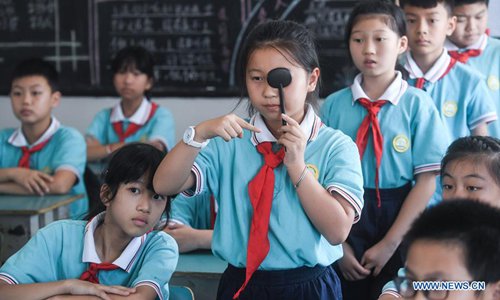More than half of children and adolescents in China were suffering from short sightedness in 2020: national health commission

A student checks the eyesight in Donglin primary school in Donglin Township of Huzhou City, east China's Zhejiang Province, Sept. 4, 2018. Classes are being taken to popularize the knowledge of protecting eyes as China aims at curbing the rise in nearsightedness-or myopia-among children and teenagers. (Xinhua/Xu Yu)
Around 52.7 percent of children and adolescents in China were found be suffering from short sightedness in a survey targeting 2.48 million students from 8,604 schools in 2020, according to data released by the National Health Commission on Tuesday.
"The overall short sightedness rate of children and adolescents in China increased by 2.5 percent compared with 2019, but it is still down from 53.6 percent in 2018," Wang Ningli, director of Beijing Tongren Hospital, said during a press conference held by the National Health Commission on Tuesday.
Wang said that in the first half of 2020, people spent more time staying at home due to the epidemic. This reduced the time spent on outdoor activities which helps to relax their eyes. This brought challenges to the prevention and control of myopia.
The survey was carried out from September to December in 2020, it found that 14.3 percent of six-year-old children, 35.6 percent of primary school students, 71.1 percent of junior school students, and 80.5 percent of high school students were suffering from short sightedness.
The problem of myopia in children is still prominent, Wang noted.
In 2020, the myopia rate of 6-year-old children exceeded 9 percent in different regions, and the highest rate reached 19.1 percent.
The rate of myopia increases rapidly in primary schools, growing from 12.9 percent in the first grade to 59.6 percent in the sixth grade, that is, for every grade higher, the myopia rate increase by 9.3 percent. The data shows that kindergartens and primary schools are the key period for myopia prevention and control in China.
The data also shows that nearly 10 percent of myopic students suffer from high myopia, and the proportion increases with each grade. Around 1.5 percent of 6-year-old children in kindergarten, 17.6 percent of students in high school suffer from high myopia, Wang noted.
